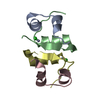+Search query
-Structure paper
| Title | Statistically correcting dynamical electron scattering improves the refinement of protein nanocrystals, including charge refinement of coordinated metals. |
|---|---|
| Journal, issue, pages | Acta Crystallogr D Struct Biol, Vol. 77, Issue Pt 1, Page 75-85, Year 2021 |
| Publish date | Jan 1, 2021 |
 Authors Authors | Thorsten B Blum / Dominique Housset / Max T B Clabbers / Eric van Genderen / Maria Bacia-Verloop / Ulrich Zander / Andrew A McCarthy / Guy Schoehn / Wai Li Ling / Jan Pieter Abrahams /   |
| PubMed Abstract | Electron diffraction allows protein structure determination when only nanosized crystals are available. Nevertheless, multiple elastic (or dynamical) scattering, which is prominent in electron ...Electron diffraction allows protein structure determination when only nanosized crystals are available. Nevertheless, multiple elastic (or dynamical) scattering, which is prominent in electron diffraction, is a concern. Current methods for modeling dynamical scattering by multi-slice or Bloch wave approaches are not suitable for protein crystals because they are not designed to cope with large molecules. Here, dynamical scattering of nanocrystals of insulin, thermolysin and thaumatin was limited by collecting data from thin crystals. To accurately measure the weak diffraction signal from the few unit cells in the thin crystals, a low-noise hybrid pixel Timepix electron-counting detector was used. The remaining dynamical component was further reduced in refinement using a likelihood-based correction, which was introduced previously for analyzing electron diffraction data of small-molecule nanocrystals and was adapted here for protein crystals. The procedure is shown to notably improve the structural refinement, in one case allowing the location of solvent molecules. It also allowed refinement of the charge states of bound metal atoms, an important element in protein function, through B-factor analysis of the metal atoms and their ligands. These results clearly increase the value of macromolecular electron crystallography as a complementary structural biology technique. |
 External links External links |  Acta Crystallogr D Struct Biol / Acta Crystallogr D Struct Biol /  PubMed:33404527 / PubMed:33404527 /  PubMed Central PubMed Central |
| Methods | EM (electron crystallography) / X-ray diffraction |
| Resolution | 2.3 - 3.26 Å |
| Structure data |  PDB-6zhb:  PDB-6zhj:  PDB-6zhn:  PDB-6zi8: |
| Chemicals |  ChemComp-ZN:  ChemComp-CA:  ChemComp-CL:  ChemComp-HOH: |
| Source |
|
 Keywords Keywords | HORMONE / INSULIN FAMILY / CARBOHYDRATE METABOLISM / HORMONE-GROWTH / HYDROLASE / metalloproteinase / PLANT PROTEIN / nanocrystals |
 Movie
Movie Controller
Controller Structure viewers
Structure viewers About Yorodumi Papers
About Yorodumi Papers





 thaumatococcus daniellii (katemfe)
thaumatococcus daniellii (katemfe)